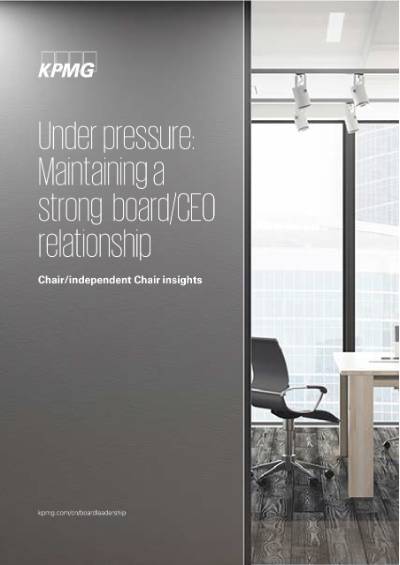Under pressure: Maintaining a strong board/CEO relationship
Under pressure: Maintaining a strong board/CEO rel...
Chair/independent Chair insights

As many boardroom leaders know from experience, achieving that “healthy tension” in the boardroom – where the board is a resource to the CEO and management team while maintaining objectivity, independence, and skepticism – is not easy. It is also clear that striking that critical balance will only become more challenging and more important given the mounting complexity of the business environment and the tremendous pressure on boards and CEOs to deliver results.
Rapid technological change and business model disruption, COVID-19 and threat of a deep recession, geopolitical uncertainty, and investor demands to hold CEOs and boards more accountable for performance all place possible strains on the board/CEO relationship. As the authors of “The CEO Life Cycle” note, this intensifying external pressure “raises the odds of adversarial dynamics between CEOs and directors, leaving many CEOs feeling unsupported and misunderstood.”1
As our interviews made clear, the pressures on the CEO and board are likely to intensify – particularly with COVID-19 and a recession complicating an already challenging business environment – making a healthy relationship between the board and CEO even more important. Emphasising the importance of working with the CEO and the board to develop and maintain a healthy board/CEO relationship, the Chairs we spoke with collectively highlighted key areas of focus Chairs in their efforts to foster such a relationship:
- Insist on candour and transparency, which are key to building a culture of trust and confidence.
- Set clear expectations that the board’s role extends beyond compliance and monitoring, and includes ongoing engagement in strategy, exposure to the organisation’s talent, and serving as a resource for the CEO and management.
- Ensure that the CEO and board agree on how the firm will be run.
- Assess whether the board’s composition and culture enable it to serve as a resource for the CEO and management.
- Insist that the CEO take the lead in driving the right relationship with the board.
- Consider how the Chair, as the point person for the independent directors, can facilitate a healthy board/CEO relationship.
- James M. Citrin, Claudius A. Hildebrand, and Robert J. Stark, “The CEO LifeCycle,” Harvard Business Review, November–December2019.
© 2025 KPMG Huazhen LLP, a People's Republic of China partnership, KPMG Advisory (China) Limited, a limited liability company in Chinese Mainland, KPMG, a Macau SAR partnership, and KPMG, a Hong Kong SAR partnership, are member firms of the KPMG global organisation of independent member firms affiliated with KPMG International Limited, a private English company limited by guarantee. All rights reserved.
The KPMG name and logo are trademarks used under license by the
independent member firms of the KPMG global organisation.
For more detail about the structure of the KPMG global organisation please visit https://kpmg.com/governance.
